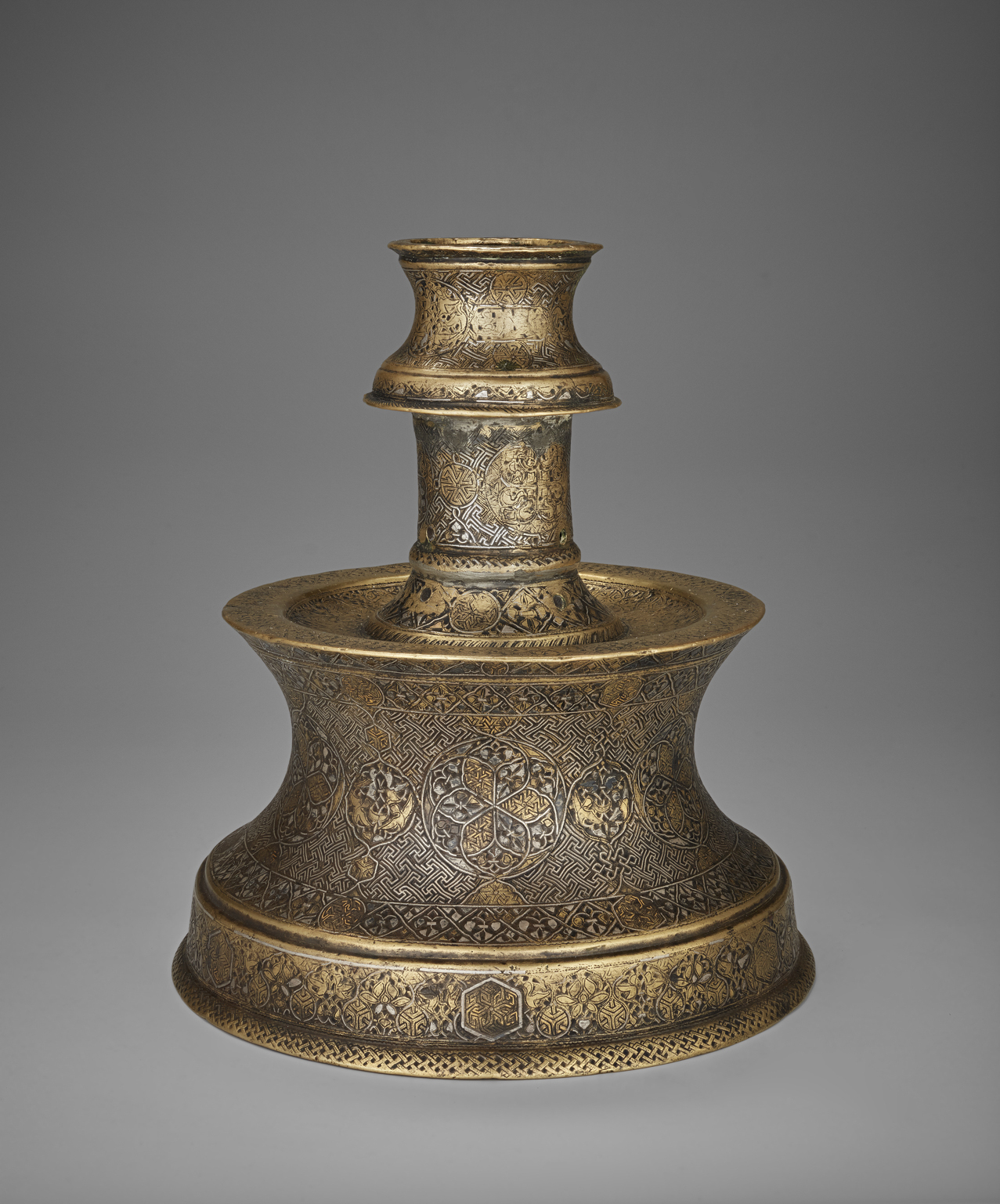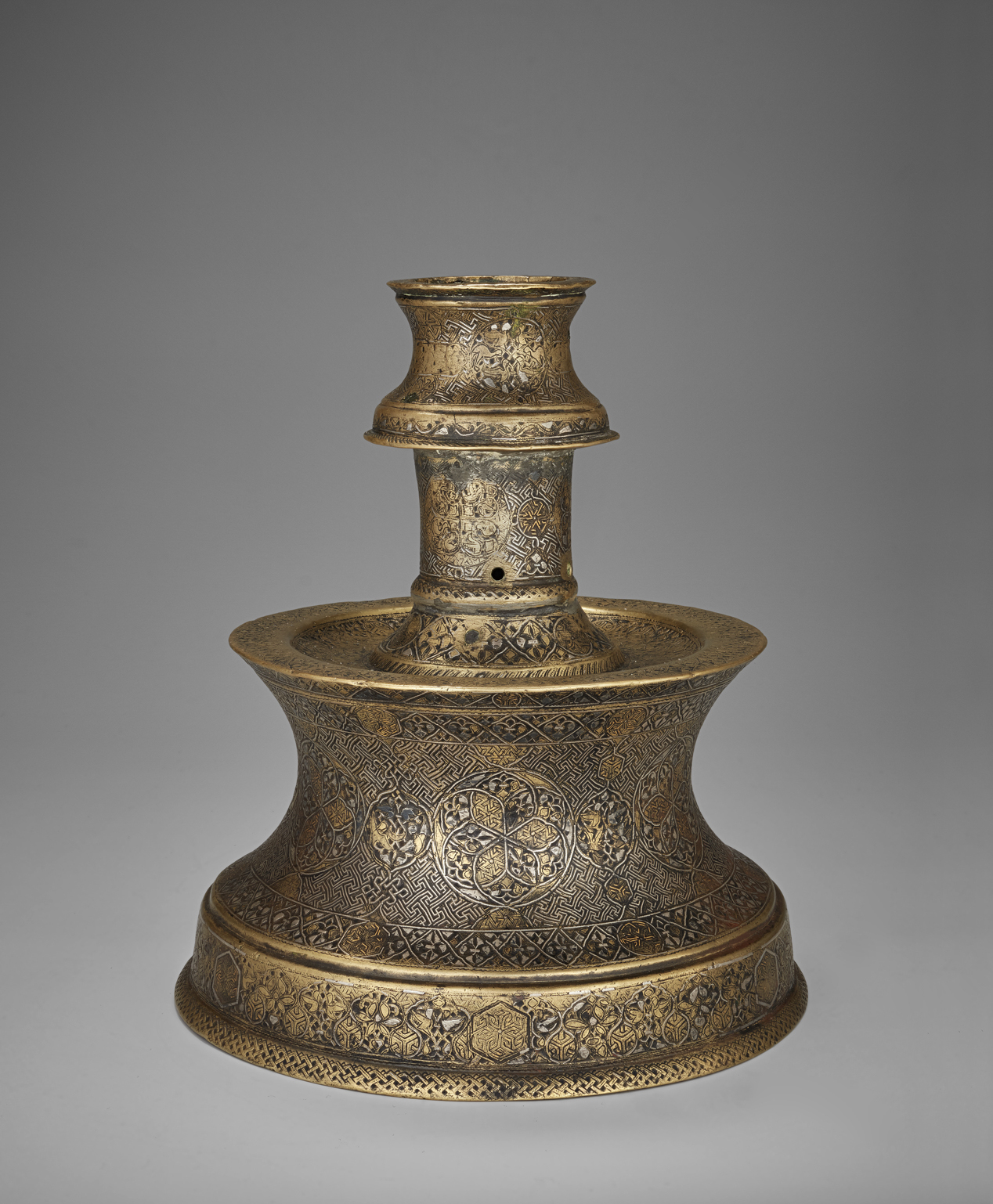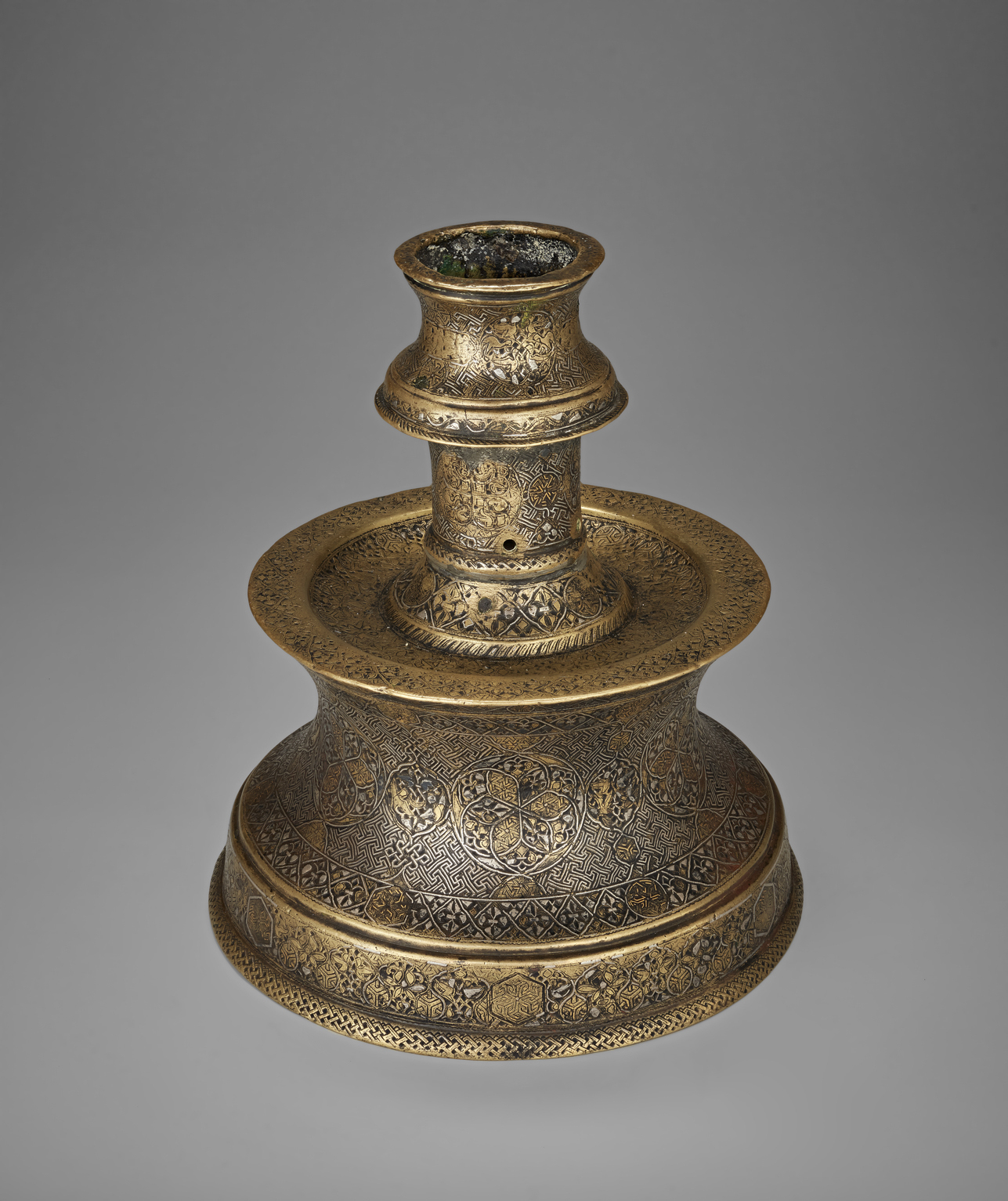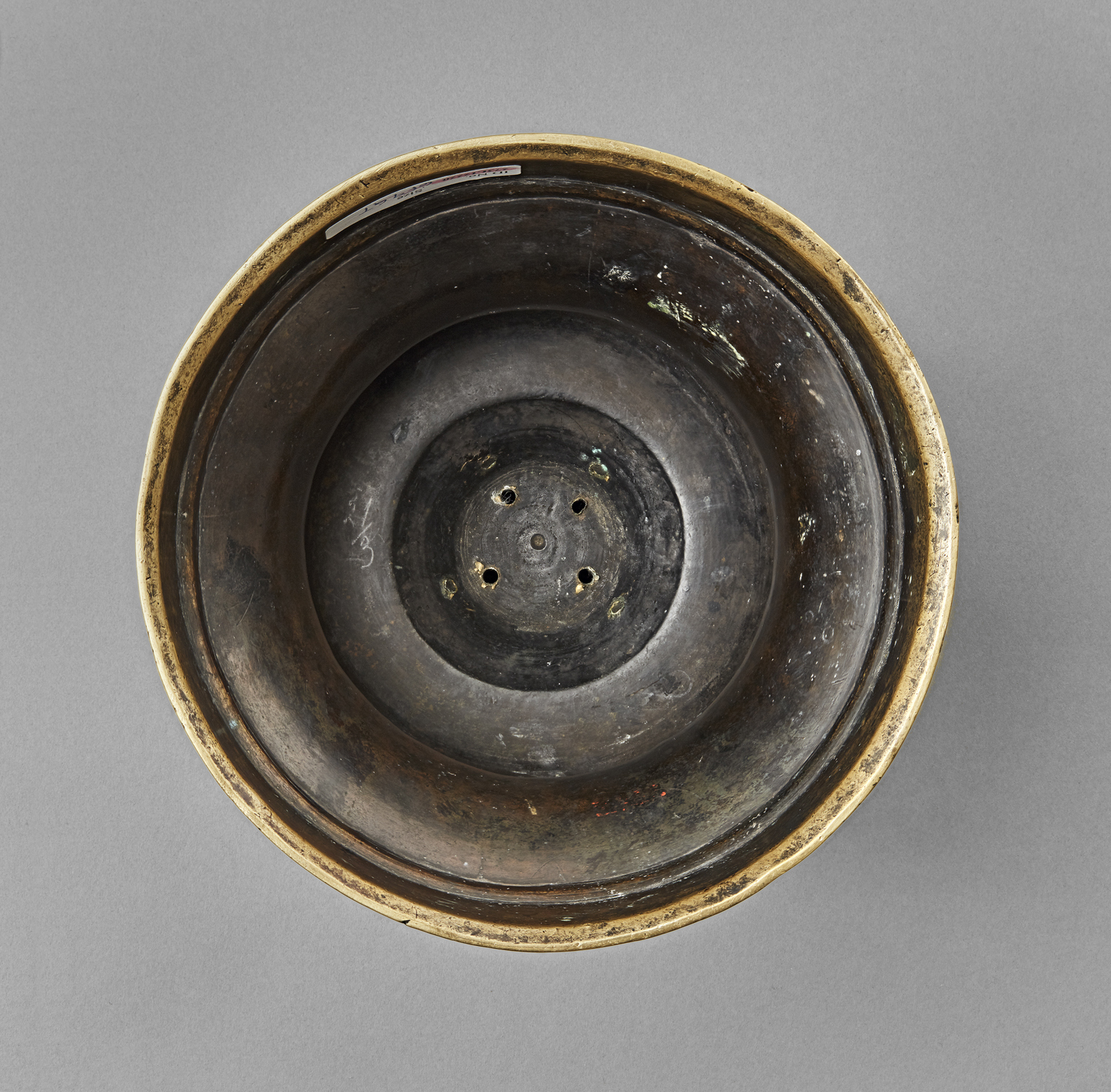Click on the image to zoom
Candlestick
- Accession Number:AKM962
- Place:Northern Iraq (Possibly Mosul) or Western Iran
- Dimensions:height: 20 cm; diameter: 18 cm
- Date:ca. 1300–50
- Materials and Technique:brass; cast, engraved, and inlaid with silver, gold, and black compound
With its truncated body, this candlestick belongs to a group of lighting devices that was popular during the medieval period from Egypt to Central Asia. Its design consists of interlacing medallions filled with arabesque-like patterns, smaller fretwork medallions, and simple pairs of birds that develop out of the stems and are almost hidden within the foliate scrolls. Its surface has been fully engraved and inlaid in silver. Remains of gold inlays confirm that details, such as the octagonal star-like fretwork medallions or the smaller circular fretwork motifs, were originally accentuated. The elaborate and costly technique provides this candlestick with a polychrome, glittery, and shiny appearance, transforming a utilitarian object into a luxurious artwork for elite households, palaces, or ceremonial contexts.
Further Reading
In use since at least the 12th century, when truncated candlesticks developed in the Khurasan (particularly in Herat, where a school of inlaid metalwork flourished), this type of candlestick together with the refined craftsmanship of inlaid metalworking were introduced to Mosul in the early 13th century. Both eventually reached other Near Eastern centres from Egypt to Anatolia, and remained popular until the early modern period.[1] A variety of shapes and decorative repertoires exist, attesting to the numerous workshops that produced them. The curvilinear body with flattened and concave recessed shoulder on a vertical but slightly inclined foot evoking a bell suggest this candlestick’s relation to Ilkhanid, and to a certain extent, Timurid examples. The inclusion of a lotus flower (a Chinese symbol of purity and motif) reveals a preference for chinoiserie expressed in Ilkhanid metalwork by the early 14th century.[2]
The composition and decorative repertoire are reminiscent of the al-Mawsuli school of inlaid brass production, which, following the Mongol conquest in 1258 remained active in Mosul where it particularly thrived during the first half of the 14th century. One of the most prominent comparative examples is the famous Courtauld Bag, attributed to Mosul of the early 14th century.[3] Consistent in style with examples from this school are the polylobed arches running along the foot or on the concave recessed shoulder, commonly used to enclose standing figures, but structuring here pairs of birds that alternate with the lotus flowers.[4] Most prominent are the interlacing star-like fretwork used in octagonal medallions, which became a hallmark of the al-Mawsili school in the early 13th century.[5] However, here the pattern is inlaid in gold, reflecting a later fashion.[6] Other comparable features are the interlacing overall design that includes larger circular medallions enclosing a star-pattern, filled with small star-fret motifs and arabesques, as well as small circular medallions featuring foliage with pairs of duck-like birds, all set against a background of T-fretwork. While the idea of such interlacing design was known since the early 13th century, comparisons with Chinese silks attest to the fluidity of ideas across media that was transferred to inlaid metalwork from Ilkhanid Mosul. This candlestick appears as though it were “dressed-up” in a precious garment, and the wavy T-fretwork evokes a sense of movement.[7]
The small dimensions of this candlestick make it unsuitable for lighting a large area and suggest it was used in a domestic or ceremonial setting. Lavishly decorated candlesticks such as this would be featured in courtly and wealthy households as part of a larger set of inlaid brass objects.[8] Representative of a ruler’s wealth and power, the candlestick could also be used for specific ceremonial occasions, during which the light of the flame would shimmer against the metallic surface and create a glamorous atmosphere.[9] The Persian verses on a strikingly similarly shaped, proportioned, and designed example in the Museum für Islamische Kunst, Berlin underlines the magical powers of such devices and candles: “And truly, as long as the candle remains burning, it remains a blessing to me as its body goes down. Mankind is Earth with all misfortune and you are heaven above them, therefore there is strength and duration as long as tomorrow and evening are in conflict.” [10]
— Deniz Beyazit
Notes
[1] Beyazit, in Canby, Beyazit, and Rugiadi 2016, 88–91.
[2] Introduced to Ilkhanid art in the second half of the 13th century, the lotus flower became ubiquitous in inlaid metalwork after 1300, thus indicating a postquem dating for this candlestick. Carboni, in Carboni and Komaroff 2002, 209-210, quotes the Penbox by Mahmud ibn Sunqur, dated 650/1281–82, in the British Museum, as the only dated inlaid object depicting the lotus flower that is pre-1300. On the lotus flower and its appearance in near eastern art and specifically metalwork of the Mamluks and Ilkhanids, see also Meinecke 1972, 213–87; Rogers 1973, 387; Ward 1993, 113.
[3] See the exhibition catalogue on the Courtauld Bag, Ward, 2014.
[4] See, for example, the candlestick by ‘Ali ibn ‘Umar ibn Ibrahim al-Sankari al-Mawsali, dated 717/1317–18 in the Benaki Museum (Ward 2014, fig. 34), or the Ewer made by ‘Ali ibn ‘Abdallah al-‘Alawi al-Naqqash al-Mawsili (Ward 2014, fig. 35, cat. 24, 142–6).
[5] See Julian Raby (2012, 31, fig. 1.9), who identified this octagon motif as a possible workshop or guild emblem.
[6] The ewer in the Walters Art Museum, dated 644H./1246-47, figures among the earliest datable examples with inlaid highlights in gold. See Beyazit, in Canby, Beyazit, and Rugiadi, 2016, 138, cat. 68.
[7] See Allen, in Ward 2014, 52–55 on Chinese silks and Mosul metalwork. Good examples to compare with the design of this candlestick are (all examples illustrated in Ward 2014): Courtauld Bag, Mosul, early 14th century (76–80); a penbox in the Louvre Museum ca. 1300–50 (fig. 43); and the ball-support from the Nisan Tası, dated 728/1327–28 (fig. 46).
[8] Beyazit, in Canby, Beyazit, and Rugiadi 2016, 155–6, and note 2.
[9] There are remains of a possibly benedictory inscription on the neck. Such protective inscriptions which were common on medieval utilitarian objects.
[10] The candlestick is in the Museum für Islamische Kunst, Berlin. The passage is translated from German, see von Gladiß 2012, 66, cat. 39.
References
Canby, Sheila, Deniz Beyazit, and Martina Rugiadi. Court and Cosmos: The Great Age of the Seljuqs. New York: The Metropolitan Museum of Art, 2016. ISBN: 9781588395894
Carboni, Stefano and Linda Komaroff, eds. The Legacy of Genghis Khan: Courtly Art and Culture in Western Asia, 1256–1353. New York: The Metropolitan Museum of Art, 2002. ISBN: 9781588390721
Von Gladiß, Almut. Glanz und Substanz: Metallarbeiten in der Sammlung des Museums für Islamische Kunst (8. Bis 17. Jahrhundert). Berlin: Museum für Islamische Kunst, Staatliche Museen zu Berlin, 2012. ISBN: 978-3943964073
Meinecke, Michael. “Zur mamlukischen Heraldik.” Mitteilungen des deutschen Archäologischen Instituts, Abteilung Kairo 28/2 (1972): 213–87.
Raby, Julian. “The Principle of Parsimony and the Problem of the ‘Mosul School of Metalwork.” In Metalwork and Material Culture in the Islamic World: Art, Craft and Text, eds. Venetia Porter and Mariam Rosser-Owen. London: I.B. Taurus, 11–85. ISBN: 9781780763231
Rogers, J. Michael. “Evidence for Mamluk-Mongol Relations 1260-1360.” In Colloque du millénaire du Caire, eds. André Raymond, J. Michael Rogers, and Magdi Wahba. Berlin and Cairo, 1973, 385–404.
Ward, Rachel. Islamic Metalwork, London: British Museum, 1993. ISBN: 9780714114583
---., ed. Court and Craft: A Masterpiece from Northern Iraq. London: The Courtauld Gallery, 2014. ISBN: 9781907372650
Note: This online resource is reviewed and updated on an ongoing basis. We are committed to improving this information and will revise and update knowledge about this object as it becomes available.








